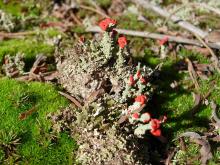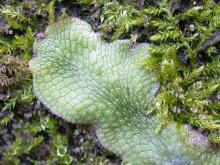Mosses, Liverworts, and Lichens
Media

Species Types
Scientific Name
Cladonia cristatella
Description
British soldier lichen is widespread in eastern North America. Branching stalks with bright red knobs at their tips arise from a patch of small, green scalelike structures. The red is similar to the color of British soldiers’ coats during the American Revolution.
Media

Species Types
Scientific Name
About 112 species in Missouri
Description
Liverworts, along with mosses, make forest floors, streamsides, and spring openings beautiful. They’re fascinating but overlooked.
Media

Species Types
Scientific Name
Frullania eboracensis
Description
New York scalewort is the most common and easily recognized leafy or scaly liverwort. It forms tiny, delicate traceries on tree bark and is usually rusty or purplish red or green.
Media

Species Types
Scientific Name
About 436 species in Missouri
Description
A lichen is a composite organism formed by certain fungus species that join with certain algae species. Lichens can be many colors and can be crusty, leaflike, flaky, branching, or mossy. They grow on rocks, trees, or other surfaces.
See Also
About Mosses, Liverworts, and Lichens in Missouri
Mosses, liverworts, hornworts, and lichens seem rather similar, but these organisms are in very different groups. Mosses, liverworts, and hornworts are small, low plants usually found in damp habitats. Unlike more familiar plants, they lack veinlike structures and do not produce flowers or seeds — instead, they produce spores. Meanwhile, lichens are not plants at all: they are a collection of different fungi that have photosynthetic algae living within their tissues.





















